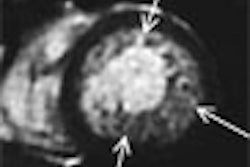In 2005, a Kansas City, MO-based plastic surgeon made the news when he left an old personal computer on his curb for trash pickup. The computer's hard drive had not been effectively erased, and it contained reams of patient data, including before and after pictures of cosmetic and reconstructive surgeries. Lawsuits continue to swirl around this episode in which confidentiality was shattered for dozens, perhaps even hundreds, of patients (Kansas City Star, July 14, 2005).
More recently, an (unpublished) account surfaced of a radiologist determined to erase the contents of an old hard drive -- perhaps in an effort to avoid the same debacle as the plastic surgeon. But where, oh where, could a radiologist find an electromagnet strong enough to erase a computer hard drive? According to the story, the following occurred ...
"No," said the technologist when asked if the computer could be taken into the MRI room to erase it. However, when the technologist was busy, the doctor ignored the prohibition and carried a box containing the soon-to-be-discarded computer into the magnet room. The magnet pulled the box from the physician's grasp. The box was about to make its way into the bore, but there was something blocking its entry -- the patient lying on the table at the time!
The patient and computer box became wedged into the opening. The magnet was ultimately quenched to extricate the patient and the computer with the now-erased hard drive. The patient was uninjured.
This account -- along with thousands of similar inadvertent, imbecilic, and incomprehensible MRI accidents -- will be retold in this sort of forum as anecdotes because the vast majority of accidents in the MRI suite go unreported. Even when a person is injured, the vast majority of these incidents are swept under the carpet.
Take, as an example, the U.S. Food and Drug Administration (FDA) database of medical device accidents. Over a 10-year period, the FDA cataloged a total of 389 incidents in MRI facilities throughout the U.S. (an average rate of less than one incident per state per year).
Contrast this with the data from the Pennsylvania Patient Safety Authority that, over just a 16-month period, tallied 88 MRI incidents from those facilities that are subject to mandatory state reporting. Fortunately, every MRI incident in the Pennsylvania database over that period was a "near miss" that did not result in injury. But the gross disparity between the FDA's data and that of just the state of Pennsylvania leads one to seriously question the accuracy and value of the FDA's numbers.
This concern is not limited to only armchair statisticians, either. Dr. Emanuel Kanal, chair of the American College of Radiology (ACR) MR Safety Committee, believes the FDA database represents less than 10% of MRI injury accidents. This is based on anecdotal accounts and his own experiences, called as an expert witness for injury-related litigation. Dr. John Gosbee, a director with the Veterans Affairs (VA) National Center for Patient Safety, has compared the FDA's data with that collected internally to the VA and believes that the FDA's public record captures something closer to 1% of the number of actual events.
ECRI, a nonprofit healthcare consulting group, conducted a small survey of MRI facilities and found that 60% of respondents indicated that their facility had experienced a projectile accident. But because projectile accidents are not necessarily the product of a malfunction of an FDA-approved MRI system, the FDA is very ambiguous about whether these accidents are required to be reported.
So what is the upshot of under-reporting of accidents in the MRI suite by one or two orders of magnitude? Patients, staff, clinicians, and regulatory bodies are vastly underestimating the accident risks in MRI suites. This leads many to shrug off accident prevention tools, such as the ACR's four-zone principle, effective suite design, and ferromagnetic detection as economically unjustifiable.
In other areas of our lives, if the risks went up tenfold we would make significant changes. What if the current number of burglaries in your neighborhood increased by tenfold? How about 10 times the known number of assaults at your child's school? These examples sound more like crime waves than simple miscalculations, don't they? What if we're really underestimating by a factor of 100 instead of 10, as Dr. Gosbee theorizes. How strongly would that impact our behavior?
Unfortunately, without accurate accident data in a public venue, individuals and facilities have little choice other than to trust in the information and advice of experts in the field. The consensus of many experts seems to be that accident rates are rising, and that increasing patient age, coupled with the increasing use of interventional MR imaging, are setting the stage for rapid growth in the rate of accidents.
Given the potential for significant revenue loss and enormous repair bills from MRI accidents, a very modest increase in the perceived level of risk and facility liability would justify significant patient safety improvements.
By Tobias Gilk
AuntMinnie.com contributing writer
October 27, 2006
Reprinted from www.mri-planning.com by permission of the authors. If you would like more information on any aspect of MR facility design or safety, please contact Robert Junk or Tobias Gilk at Jünk Architects.
Related Reading
DRA and MR patient throughput -- reimbursement cuts vs. unconventional wisdom, October 17, 2006
Buying an MRI: A tragedy in two acts, September 25, 2006
MRI safety in Canada, September 1, 2006
Magnet room finishes: Protect MRI safety and efficiency when building, August 14, 2006
What TV's 'House' teaches us about MRI and safety, August 1, 2006
Copyright © 2006 Jünk Architects, PC



.fFmgij6Hin.png?auto=compress%2Cformat&fit=crop&h=100&q=70&w=100)




.fFmgij6Hin.png?auto=compress%2Cformat&fit=crop&h=167&q=70&w=250)











